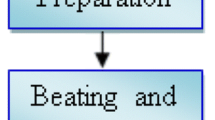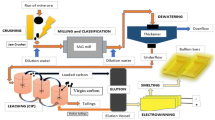Summary
Observations on selective absorption and leaching suggest that the chromium fixes the arsenic preferentially to the copper. Although there appears to be no major amount of fixation of copper by arsenic, at the start of addition of arsenic to copper-chrome formulations there is a small but significant decrease in the leaching of the copper suggesting either a small amount of fixation of copper by arsenic or the formation of an insoluble complex of all three components.
Maximum fixation of arsenic was obtained when the Cr/As ratio (as salts) was 1.9 or greater. Maximum fixation of copper is not so simply defined but is round about a Cr/Cu ratio (as salts) of 1.7.
The area of maximum effectiveness is not coincident with the area of maximum fixation of both copper and arsenic but slightly displaced towards a region higher copper where there is still maximum fixation of arsenic but some loss of copper.
Similar content being viewed by others
References
Bailey, C. H., Rose, G. R. F. 1960. Metal-organic complexes formed during the treatment of wood with metal salts. Nature, Lond. 185: 313–314.
Belford, D. S., Preston, R. D., Cook, C. D., Nevard, E. H. 1957. Timber preservation by copper compounds. Nature, Lond. 180: 1081–1083.
—, Myers, A., Preston, R. D. 1958. Electron diffraction study of adsorbed metal ions on the surface of cellulose microfibrils. Nature, Lond. 181: 1516–1518.
—, Myers, A., Preston, R. D. 1959. A study of the ordered adsorption of metal ions on the surface of cellulose microfibrils. Biochim. biophys. Acta. 34: 47–57.
Bland, D. E. 1963. Sorption of copper by wood constituents. Nature, Lond. 200: 267.
Eadie, J., Wallace, E. M. 1962. Some observations on the fixation of copper and arsenic in Pinus sylvestris sapwood. J. Inst. Wood. Sci. 10: 56–65.
Häger, B. 1969. Leaching tests on copper-chromium-arsenic preservatives. Forest Prod. J. 19: 21–26.
Henry, W. T., Jeroski, E. M. 1967. Relationship of arsenic concentration to the leachability of chromated copper arsenate formulations. Proc. Amer. Wood Pres. Ass. 63: 187–192.
McMahon, W., Hill, C. M., Koch, F. C. 1942. Greensalt—A new preservative for wood. Proc. Amer. Wood Pres. Ass. 38: 334–348.
Michie, R. I. C. 1961. Sorption of copper by cellulose. Nature, Lond. 190: 803–804.
Author information
Authors and Affiliations
Rights and permissions
About this article
Cite this article
Smith, D.N.R., Williams, A.I. The effect of composition on the effectiveness and fixation of copper/chrome/arsenic and copper/chrome preservatives part II: Selective absorption and fixation. Wood Science and Technology 7, 142–150 (1973). https://doi.org/10.1007/BF00351156
Received:
Issue Date:
DOI: https://doi.org/10.1007/BF00351156




